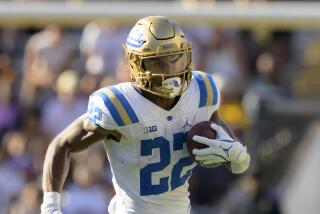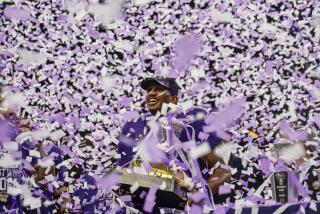COLLEGE FOOTBALL ’91 : PACIFIC 10 CONFERENCE PREVIEW : Have-Nots Now Have More Than Before
- Share via
When the Pacific 10 Conference had only eight members in the 1970s, someone jokingly referred to the league as John McKay and the seven dwarfs.
That was in reference to the USC coach’s dominating teams.
Perhaps there is a recurring theme in the early 1990s--with the Washington Huskies leading the pack.
Washington is the clear-cut favorite to repeat as conference champion, despite the loss of quarterback Mark Brunell, who suffered torn knee ligaments in spring practice.
Otherwise, Coach Don James has 15 starters from a team that went 10-2 last season, lost a chance at the national championship when it was upset by UCLA late in the regular season, 25-22, then easily beat Iowa in the Rose Bowl game, 46-34.
All of that, however, isn’t meant to suggest that the Pac-10 is weak. Far from it. USC and UCLA will be factors, as usual, even though the Bruins are coming off two losing seasons. Oregon and California have substantially improved their programs, and Stanford could be the surprise team if it can survive a demanding nonconference schedule.
Oregon Coach Rich Brooks says the league has never been stronger, especially since the previous have-nots, such as his team, are better.
“Over the years, the conference has gotten better and better every year,” UCLA Coach Terry Donahue said. “Facilities have improved and the coaching is superb. The difficulty lies as much with the diversity of the teams as the caliber of players. You have to get ready for so many different types of attacks. One week it’s the option, then the I-formation and then throwing teams such as Stanford and Washington State.”
There is more parity in the revised conference schedule, by which each teams plays eight league games.
“The Pac-10 did the right thing in revamping the schedule. The previous schedule was not fair,” Donahue said. “Some teams played nine games, others eight and seven. You don’t have to be a rocket scientist to figure out you’re better off playing fewer (conference) games.”
A look at the Pac-10, excepting USC, UCLA and Washington, with last year’s overall and conference records:
ARIZONA (7-5, 5-4, fifth)--Dick Tomey’s Wildcats were puzzling last season, beating USC and UCLA in Los Angeles, but losing to Oregon State and Stanford on the road. Arizona operates out of the I-bone, a ground-oriented offense that averaged 197.9 yards. However, the Wildcats were the league’s worst passing team, with an average of 106.2 yards.
George Malauulu has apparently won the quarterback job from redshirt freshman Charles Levy, who will also play tailback. Michael Bates, the projected starter at tailback, is pursuing a track career as an Olympic hopeful, so Levy will compete with sophomore Lamont Lovett for the starting job. The offensive line has three returning starters, led by tackle John Fina.
Linebackers Jimmie Hopkins and Marcel Wade have been moved to the defensive line, bolstering one area and weakening another. The secondary is an area of concern with the loss of three starters, Thorpe Award winner Darryl Lewis, Jeff Hammerschmidt and Todd Burden. Arizona is a young team with a difficult schedule including nonconference games against Ohio State and Miami and league road games against Washington and UCLA in successive weeks.
ARIZONA STATE (4-7, 2-5, eighth)--Coach Larry Marmie’s job is reportedly on the line this season after a three-year record of 16-16-1. The Sun Devils were hampered by injuries last season, most seriously to quarterback Paul Justin and several lineman. Justin is gone, as is tailback Leonard Russell, an NFL first-round draft choice. George Montgomery is seemingly a worthy replacement for Russell, after losing his starting job last year because of an injury.
Quarterback Bret Powers wasn’t impressive in relief of Justin. However, he has an outstanding receiver in Eric Guliford, who gained 837 yards on 48 receptions in 1990. The offensive line is experienced. There are also experienced players on defense that would be enhanced if defensive tackle Shane Collins recovers from a knee injury. The good news is that 16 starters are returning. The bad news is that the opening three games are against Oklahoma State, USC and Nebraska.
CALIFORNIA (7-4-1, 4-3-1, fourth)--The Golden Bears are coming off their first winning season in eight years, including a 17-15 victory over Wyoming in the Copper Bowl.
“You want to take advantage of what happened last year,” Coach Bruce Snyder said. “The benefits of winning, you want to share that. Where I see it as a detriment is if anybody is thinking that because we did it last year, we’ll automatically do it this year.”
The Bears have tailback Russell White, who gained 1,000 yards while sharing the position in 1990 with Anthony Wallace; seasoned quarterback Mike Pawlawski, wide receiver Brian Treggs, and an apparently capable offensive line.
However, the Bears yielded an average of 428.5 yards last season. Snyder says he is going to try an active, gambling defense that emphasizes quickness.
OREGON (8-4, 4-3, third)--The Ducks had 8-4 records in each of the last two seasons, along with bowl appearances, and there is evidence that they could be bowl-bound again if Coach Rich Brooks can find a capable quarterback to replace Bill Musgrave, now in the NFL.
Musgrave had a 25-10 record in games in which he started, and set 16 school records. Three players are competing for the position--Brett Salisbury, a junior college transfer and brother of former USC quarterback Sean Salisbury; Doug Musgrave, another transfer and Bill’s brother, and redshirt freshman Danny O’Neil.
Also returning are tailback Sean Burwell (1,022 yards rushing), tight end Jeff Thomason, who is coming back from a broken ankle, and fullbacks Brandon Jumper and Juan Shedrick. However, there is limited experience at wide receiver, and one side of the offensive line must be replaced.
The Ducks have few shortcomings on defense, with nine returning starters, among them such standouts as end Matt LaBounty, nose tackle Marcus Woods, linebacker Andy Conner and safety Eric Castle.
OREGON STATE (1-10, 1-6, 10th)--Another coach, Jerry Pettibone, will try to restore some respectability to the Beaver program. Pettibone, the former Northern Illinois coach and offensive coordinator at Oklahoma, Nebraska and Texas A&M;, succeeds Dave Kragthorpe. The Beavers haven’t had a winning season since 1970, and four coaches have lost their jobs during that span.
Pettibone’s program began on a disruptive note when he had to suspend running back Dwight Owens for violating team rules. Owens set an NCAA record for kickoff return yardage, 1,014, last year. Also, Don Shanklin, Pettibone’s prize quarterback recruit from Amarillo, Tex., failed to pass his college entrance examination. Pettibone recently said that Owens will remain in school and could be available next season. Shanklin will try to make up his grades at a nearby community college.
Pettibone has only one holdover quarterback, Ed Browning, a drop-back passer, to implement his spread option, wishbone-type offense. The new coach also has to revive a defense that yielded an average of 245 yards rushing.
STANFORD (5-6, 4-4, sixth)--The Cardinal will play Cornell in its fifth game. But then, Stanford probably will need a breather after opening with Washington, Arizona, Colorado and Notre Dame.
Halfback Glyn Milburn, dangerous as a runner, receiver and kick returner, fullback Tommy Vardell and quarterback Jason Palumbis give Coach Dennis Green scoring potential. Standout wide receiver Ed McCaffrey will be missed, however.
The massive offensive line, a collection of 300 pounders, is led by Bob Whitfield. There are seven returning starters on defense, but few with the ability of departed linebacker Jojo Tunney and cornerback Kevin Scott.
WASHINGTON STATE (3-8, 2-6, ninth)--Coach Mike Price went through three quarterbacks last season before he finally settled on Drew Bledsoe, a 6-foot-5, pro-style passer. Bledsoe, a sophomore, will be throwing to Clarence Williams, perhaps the best pass-catching tight end in the league, and Phillip Bobo, who caught 51 passes for 758 yards.
Only four starters return from a unit that yielded an average of 441.5 yards and 34.6 points. Three teams scored 50 or more points against Washington State in 1990.
Price has the best punter-kicker in the nation in Jason Hanson, who led the Pac-10 with a 45.4-yard punting average and had a conference-leading 17 field goals.
More to Read
Go beyond the scoreboard
Get the latest on L.A.'s teams in the daily Sports Report newsletter.
You may occasionally receive promotional content from the Los Angeles Times.










